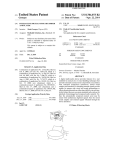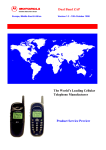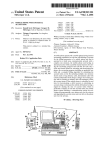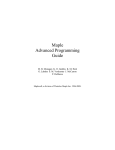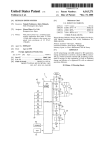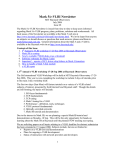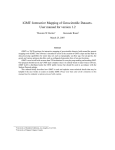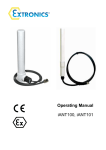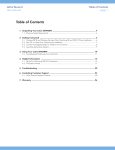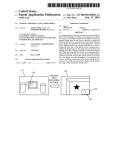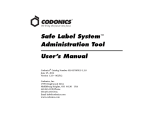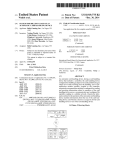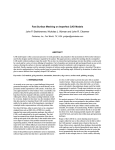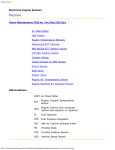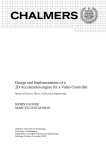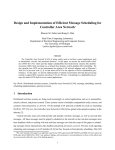Download Mobile security system with cellular transceiver, position reporting
Transcript
US006532360B1 (12) United States Patent Shalfer (54) (10) Patent N0.: (45) Date of Patent: MOBILE SECURITY SYSTEM WITH CELLULAR TRANSCEIVER, POSITION REPORTING AND REMOTE ACTUATION 5,742,666 A 5,786,789 A 5,805,055 A M. Bennett Sha?'er, 514 N. Bluff St., St. George, UT (US) 84770 (*) Subject to any disclaimer, the term of this patent is extended or adjusted under 35 Notice: 5,894,266 A 5,918,180 A * (21) Appl. No.: 09/460,753 (22) Filed: Dec. 14, 1999 Int. Cl.7 ......................... .. H04M 11/00 (52) US. Cl. ..................... .. 455/404; 455/426; 455/414; (58) Field of Search ............................... .. 455/521, 404, 455/456; 340/426 455/426, 345, 414, 456, 422; 342/42, 825; 340/902, 426, 990, 425, 539 References Cited U.S. PATENT DOCUMENTS 4,100,529 A 7/1978 Evans 4,339,753 A 7/1982 Mawhinney 4,724,538 4,833,477 5,055,851 5,081,667 5,155,689 5,185,779 5,247,564 5,334,974 5,365,570 5,388,147 5,418,537 5,552,789 5,555,286 5,572,201 A A A A A A A A A A A A A A 5,708,417 A 5,712,619 A 2/1988 5/1989 10/1991 1/1992 10/1992 2/1993 9/1993 8/1994 11/1994 2/1995 5/1995 9/1996 9/1996 11/1996 * ColiZZa .................... .. 340/426 * * 4/1999 6/1999 Wood et a1. .............. .. 340/506 Dimino .................... .. 455/456 7/1999 Lin 8/1999 Settles et 81. 5,986,543 A * 11/1999 6,028,537 A * 2/2000 Suman et a1. 6,067,007 * 5/2000 A Johnson .................... .. 340/426 Gioia ... ... ... . 6,133,832 A * 10/2000 Winder et a1. 6,167,255 * 12/2000 6,262,656 B1 * 7/2001 A Kennedy ..... Farrell Tendler Sheffer Drori et 81. Wortham Dop et al. Zicker Simms et 81. Boubelik Grimes Bird Schuermann Tendler Graham et 81. 340/426 340/10.4 . . . .. 455/414 Byrd et a1. .............. .. 307/10.2 Alpine Electronics, User’s Manual, Alpine Mobile Mayday System (On—Guard), ATX Technologies, Inc. (1999). NeWs Release, Cars: Calling for Help, Automatically, by Ann M. Job, Sep. 13, 1999. * cited by examiner Primary Examiner—EdWard F. Urban Assistant Examiner—KhaWar Iqbal (74) Attorney, Agent, or Firm—TraskBritt (57) ABSTRACT A mobile security system for use in an automobile or other vehicle, Which activates a cellular phone to automatically dial an emergency telephone number and plays a voice recording including position information provided by the vehicle operator. The vehicle operator is prompted to record neW position information When the vehicle ignition is turned off. The system can be remotely activated by a Wireless transmitter device Which generates an RF signal When a “panic button” is depressed. Components of the security system include a cellular telephone, RF receiver device, recording device, and controller. A speaker and microphone permit tWo-Way communication betWeen the vehicle opera tor and emergency personnel. 1/1998 Tallman et a1. ........ .. 340/425.5 1/1998 Simkin 340/426 . . . .. OTHER PUBLICATIONS (51) (56) 9/1998 11/1998 Revell et 81. 5,926,752 A 5,933,074 A U.S.C. 154(b) by 0 days. Mar. 11, 2003 4/1998 Alpert 7/1998 Janky 5,838,237 A (76) Inventor: US 6,532,360 B1 14 Claims, 4 Drawing Sheets U.S. Patent Mar. 11, 2003 Sheet 1 0f 4 US 6,532,360 B1 .GEF U.S. Patent Mar. 11,2003 Sheet 3 0f 4 54 50 WEAK SIGNAL READY % I: j 52 US 6,532,360 B1 \ 53 51 FIG. 3 5O 56 \ / fié >//54 E; FIG. 4 U.S. Patent Mar. 11,2003 Sheet 4 0f 4 US 6,532,360 B1 60 61 FIG. 5 64 60 FIG. 6 US 6,532,360 B1 1 2 MOBILE SECURITY SYSTEM WITH The inventive system has the further advantage that it can CELLULAR TRANSCEIVER, POSITION be activated by a user that is either inside or outside of the REPORTING AND REMOTE ACTUATION vehicle. It has the further advantage that either a pre-recorded BACKGROUND OF THE INVENTION 1. Field of the Invention The invention relates generally to the ?eld of personal security systems, the ?eld of vehicle emergency signal and position transmission systems, and to the ?eld of mobile telephone systems for emergency and security use. It relates emergency message can be transmitted, or the vehicle user may establish direct tWo-Way communication With an emer gency operator. 10 BRIEF DESCRIPTION OF THE SEVERAL VIEWS OF THE DRAWINGS speci?cally to systems including cellular telephones capable FIG. 1 depicts the components of the invention. of automatically dialing a preset emergency telephone num ber and activating a voice recording for relaying location and identi?cation information. FIG. 2 is a schematic diagram of the invention. 2. Statement of the Art 15 Systems for generating and transmitting emergency sig nals are knoWn in the prior art. These include systems for use on boats and ships, cars or trucks, and systems to be carried on a person. Cellular phone systems for dialing a preset activation device. FIG. 6 is a side vieW of the remote activation device of FIG. 5. emergency number and transmitting a position signal rep resenting the current position of the vehicle, or, in some cases, the last recorded position of the vehicle are also knoWn in the art. In the prior art, position information is FIG. 7 shoWs an alternative embodiment of the remote activator device. obtained from a GPS or LORAN system, or determined by triangulation (or comparable calculation) from signal 25 DETAILED DESCRIPTION OF THE INVENTION An example of a presently preferred embodiment of the invention is shoWn in FIG. 1. The main components of the invention are located in alarm box 1, Which is preferably installed in a hidden location, for example the trunk 2 of vehicle 3, as shoWn here. The main components of the strength in cells of a cellular phone system. The prior art includes systems in Which GPS or similar coordinates are translated to a local street address for more convenient location of the vehicle or individual. Prior art systems have been activated by various means, including a “panic button”, car alarm activation, airbag deployment detector, or by device include cellular telephone 10, controller 20, record ing device 30, and radio frequency (RF) receiver device 40. pressing a key or sequence of keys on a telephone keypad. There remains a need for an alarm system Which is inexpensive, provides clear information about vehicle position, and can be activated by a user Who is either inside FIG. 3 is a front vieW of the user interface box. FIG. 4 is a side vieW of the user interface box. FIG. 5 is a front vieW of one embodiment of the remove 35 or outside the vehicle. Cellular telephone 10 is connected to antenna 11 via cable 12; RF receiver device 40 is connected to antenna 13 via cable 14. Antennas 11 and 13 are preferably mounted in the rear WindoW 4 of vehicle 3, but alternatively may be mounted in any other location Which provides acceptable SUMMARY OF THE INVENTION signal reception. The present invention includes a mobile security system A message providing identifying information (e.g., user name, vehicle license plate number, etc.) and location infor for use in an automobile or other vehicle and Which, When activated, uses a cellular telephone to dial a pre-set emer mation can be recorded With recording device 30. In the event of an emergency, the user activates the device either by gency telephone number and play a voice recording Which states the location of the vehicle and provides other identi fying information. The system also permits direct voice communication betWeen the occupant of the vehicle and the pressing a button 51 on user interface 50 Which is mounted inside vehicle 3, or by pressing a button 61 on remote 45 activation device 60 Which the vehicle user 70 carries on his contacted emergency operator. The system can be activated or her person. Remote activation device 60 sends an RF by depressing a sWitch or button on a user interface box signal to receiver device 40, Which signals controller 20. mounted in the vehicle, or by pressing a panic button on a Controller 20 activates cellular telephone 10 to dial a remote activation device Which the operator carries on his or pre-programmed emergency telephone number and activates her person. The remote activation device transmits an RF recording device 30 to play the pre-recorded emergency signal to a transceiver mounted in the vehicle Which then message Which includes identi?cation and location informa tion. The controller may also be programmed to activate the vehicle horn 7 or lights 9, respectively, via lines 700 or 900, or disable the vehicle upon receipt of a signal from the initiates dialing of the cellular telephone and transmission of the recorded emergency message. The remote activation device makes it possible for the user to activate the device from any location in the general vicinity of the vehicle, as Well as from inside the vehicle, thereby greatly enhancing the utility of the security system. The system utiliZes a voice recording of position information Which is recorded by the 55 to activate cellular telephone 10 to dial the pre-programmed emergency telephone number; hoWever, instead of activat ing recording device 30 to playing a pre-recorded message, operator of the vehicle and updated as needed. By using a user-recorded position message, the complexity and cost of the device is considerably reduced in comparison to systems Which utiliZe more costly GPS devices. Moreover, the tWo-Way communication betWeen the user and emergency operator is enabled. The system can be reset and transmis sion halted by pressing reset sWitch 18, Which is mounted on alarm box 1. Reset sWitch 18 is covered, recessed, or position message can include details Which are not provided by other types of position signals. The inventive system has the advantage that it can be manufactured relatively inexpensively, since it does not utiliZe a costly GPS. remote activation device 60. If button 51 on interface 50 is depressed, a signal is sent to controller 20, Which causes it 65 otherWise protected to prevent it from being depressed accidentally. Alternatively, the system may be reset using a reset button located on the remote activation device 60, on user interface 50, or elseWhere in the system. US 6,532,360 B1 4 3 record a position message indicating the current (or most Alarm boX 1 may be constructed of metal or other durable recent) location of the vehicle, the location description material, and is sized to contain cellular telephone 10, controller 20, RF receiver device 40, and recording device 30. All components residing Within alarm boX 1 are prefer ably poWered by the 12 Volt DC vehicle battery 5, Which is recorded by the user, a message containing identifying information pertaining to the vehicle or driver (e.g. vehicle make and/or model, license plate number, driver name and/or driver’s license number, etc.), and other messages Which may be used in the practice of the invention. Record ing device 30 preferably includes a plurality of memory or recording locations 31a, 31b, 31c, etc. Where the various connected to alarm boX 1 by cables 5001 and 5002. Alternatively, it Would be possible to provide a separate poWer supply (e.g., battery) for the components of the invention. Remote activation device 60 is packaged sepa rately and is preferably poWered by a battery. 10 A schematic diagram of the components of the inventive system is given in FIG. 2. Cellular telephone 10 is a conventional cellular telephone Which has been modi?ed so that its voice output signal is messages can be stored and from Which the messages can be retrieved. Recording device 30 further includes audio input 301, audio output 302, memory select input 303, and func tion select input 304. These are preferably digital inputs and outputs, Which may be either parallel or serial. Audio input sent out on line 103, so that it may be routed to speaker 52 15 301 and output 302 must have suf?cient throughput to transmit a signal of acceptable quality in a reasonable in user interface 50 via line 502. Cellular telephone 10 amount of time. Memory select input 303 accepts an input signal Which represents the memory location in Which the accepts as input 101 either the output signal 304 from recording device 30 or the audio signal on line 503 from microphone 53 in user interface 50. In an alternative desired message is to be stored, or from Which it is to be retrieved. Function select input accepts an input signal Which indicates the function to be performed by recording embodiment of the invention, audio input 101 may originate from microphone 62 in remote activation device 60. The audio signal Would be sent from receiver device 40 to controller 20 via line 402, and from there to cellular tele phone 10. Cellular telephone 10 is pre-programmed With a desired emergency number (e.g., 911, a private security device 30, ie Whether it is to record the signal on audio input 301 in the selected memory location or play the message in the selected memory location on audio output 25 company, police, or other emergency service provider) in the usual manner; hoWever, telephone 10 is modi?ed so that tions of inputs and outputs may be suitable for use in the invention, and that the invention is not limited to the auto-dialing is initiated upon receipt of an activation signal particular con?guration described here. on line 102. The audio input received on line 101 is converted to a cellular telephone signal Which is sent to antenna 11 via line 12 and transmitted to cellular telephone transceiver device 70 and routed to the emergency service provider. Cellular voice signals from the contacted emer gency service are picked up by antenna 11, carried to cellular telephone 10 on line 12, and output from cellular telephone 302. It Will be appreciated by those of ordinary skill in the art that various recording devices having various combina When a sensor 81 on the ignition 8 of vehicle 3 detects 35 10 on line 103. If the cellular phone 10 is not receiving a that ignition 8 has been shut off, a signal is generated on line 801. On detection of this signal, controller 20 generates signals memory select line 303 and function select line 304 causing recording device 30 to play a prompt message stored in memory location 31a on audio output 302. The prompt message, Which is routed to speaker 52 on line 502, instructs strong enough signal to transmit, it generates a signal on line 504 Which causes Weak signal indicator light 54 in interface boX 50 to be illuminated. If cellular phone 10 is receiving a the vehicle user to record a neW location description. strong enough signal for transmission, it generates a signal location description should be recorded. Asignal on function select line 304 enables recording device 30; the user speaks on line 505 Which causes ready signal indicator light 55 in interface boX 50 to be illuminated. RF receiver device 40 is a radio frequency (RF) receiver. RF receiver device 40 is connected to antenna 13 via cable 14. RF receiver device 40 is tuned to receive RF signals Which are generated by remote activation device 60. RF signals transmitted by remote activation device 60 include an alarm signal Which is generated When a “panic button” 61 Though less preferred, it Would also be possible to generate a beep or other sound to indicate to the user that a neW into microphone 53, and the signal from microphone 53 is 45 carried to controller 20 via line 503, routed to recording device 30 on audio input line 301, and recorded in memory location 31b. In alternative embodiments of the invention, the voice signal to be recorded could originate from micro phone 62 in remote activation device 60, or another source. In the preferred embodiment of the invention, recording is pressed, and, optionally, an audio signal picked up by a device 30 also stores a recording of identi?cation informa microphone 62 in remote activation device 60. RF receiver tion (driver name, vehicle license plate number, etc.), e. g., in device 40 sends a noti?cation signal on line 401 to controller memory location 31c. The identi?cation information is preferably recorded at the time that the inventive system is installed in the vehicle, and updated only as needed; it Would not be necessary, and indeed Would probably be inconve nient and time-consuming, to record identi?cation informa 20 When the alarm signal is received from remote activation device 60. The audio signal originating from microphone 62 is transmitted to controller 20 on line 402, and from there is routed to cellular phone 10 on audio input line 101. RF receiver device 40 receives a reset signal from controller 20 on line 403. The reset signal causes the receiver device to stop sending to controller 20 and commence Waiting for an alarm signal from remote activation device 60. In some 55 tion each time the location information Was recorded. Recording device 30 may also store a greeting or intro ductory message, e. g. in memory location 31d, Which Would be played at the start of an emergency call. In the event that an emergency occurs and the inventive system is activated, embodiments of the invention it may be desirable to use a device capable of both receiving and transmitting signals (i.e., a transceiver) in place of receiver device 40, for controller 20 Would send an activation signal to recording device 30 causing it to play back, in a predetermined sequence, the greeting, location, and identifying information stored in memory locations 31d, 31c, and 31b. The activa example, if it Were desired to transmit signals back to remote activation device 40 to permit tWo-Way communication. Recording device 30 is used to record, store and replay a number of voice messages used by the inventive system. These include a prompt message Which instructs the user to 65 tion signal could consist of a sequence of signals on memory select input 303, specifying the memory locations of the message components, accompanied by a “play” signal on US 6,532,360 B1 5 6 function select input 304, instructing the recording device to it to the user’s clothing, such as clip 64, or loop 63 or similar play back the messages in the indicated memory locations. The messages Would be played on output line 302 and routed to cellular telephone 10 via line 101 by controller 20 folloWing dialing of the emergency number. It Will be appreciated that various message components may be combined, and the practice of the invention is not limited to means Which permit it to be attached to a key chain or necklace. A ?rst example of remote activation device 60 is depicted in FIGS. 5 and 6. This embodiment of the device includes activation sWitch (button) 61, Which causes activa tion of remote activation device 60 to transmit an RF alarm signal Which is picked up by RF antenna 13 and received by recording and combining three message components from RF receiver device 40. Receiver device 40 sends an activa three memory locations, as described here. Moreover, it may be desirable to use a larger number of prompts in the system, 20 to activate cellular telephone 10 to dial the pre tion signal to controller 20 via line 401, causing controller programmed emergency message and activate recording device 30 to play the prerecorded message composed of greeting, location, and identi?cation components, Which is e.g., to prompt the user to record the identi?cation information, to provide instructions on system use, etc., and these also may be stored in and retrieved from recording device 30. The use of recording device 30 for recording location information eliminates the need for using a costly 15 GPS or similar system. Moreover, the user may record details on location not available in global coordinates or even street addresses (eg “at the back of the building”, “on the third level of the parking garage”, or “in the northbound lane of the highWay”) Which may signi?cantly aid emer gency personnel in locating the vehicle or driver. User interface 50 is preferably mounted in the front portion of the passenger compartment of vehicle 3, eg above the rear vieW mirror, as shoWn in FIG. 1. Interface box 50 is illustrated in more detail in FIGS. 3 and 4. It includes 25 a speaker 52 and microphone 53 Which are used in providing voice prompting by the system and recording of messages by the user, as described previously in connection With the recording device. Speaker 52 and microphone 53 may be of the type used in cellular phones. User interface box 50 also includes a sWitch 51 Which is preferably a button (a “panic button”). If sWitch 51 is activated (i.e. pressed, in the case that it is a button) controller 20 activates cellular phone 10 to dial the pre-programmed emergency number. The audio signal from microphone 53 is carried to controller 20 on line 503, and from there routed to cellular phone 10 on line 101, to be transmitted to the cellular telephone transceiver device 71 for routing to the emergency service provider. The signal then transmitted to the emergency operator by cellular telephone 10, as described previously. Optionally, the con troller 20 can be con?gured to cause the vehicle horn 7 to honk or to disable the vehicle ignition 8 if an alarm signal is received from remote activation device 60. An alternative embodiment of remote activation device 60 is shoWn in FIG. 7. This embodiment of the device includes all the features included in the embodiment of the invention shoWn in FIGS. 5 and 6, and also includes a microphone 62 for picking up an audio signal Which is transmitted to RF receiver device 40, sent to controller 20 on line 402, and routed to cellular telephone 10 for transmission to the emergency operator. This alloWs the user to provide a verbal message in addition to the pre-recorded location and iden ti?cation messages, and also alloWs the emergency operator to listen to any activity (sounds of distress, etc.) taking place in the vicinity of remote activation device 60. A further alternative Would be to include a receiver and a speaker in remote activation device 60, to alloW tWo-Way communica tion betWeen the user and the emergency operator; hoWever, inclusion of additional components Would lead to an 35 increase in the siZe and Weight of the device. It is anticipated that user interface box 50 Would be used to activate the system in cases Where the vehicle user could from the emergency service is sent to controller 20 on line readily reach and press button 51, and in Which tWo-Way communication Was desired, for example, if the vehicle had 103, and from there routed to speaker 52. This alloWs direct tWo-Way communication betWeen the occupant of the vehicle and the contacted emergency personnel. suspicious activity outside the vehicle. Remote activation an engine breakdoWn or ?at tire, or if the vehicle user noted device 60 Would be used in cases Where the vehicle user Was outside the vehicle, or Was inside the vehicle but unable to Weak signal indicator light 54 and ready signal indicator light 55 are mounted on the outside of box 50. Weak signal indicator light 54 is preferably a red light emitting diode (LED) and ready signal indicator light 55 is preferably a green LED. HoWever, it Will be appreciated that other colors and types of lights may be used in the practice of the invention. A cable 500 containing lines 501, 502, 503, 504 and 505 from sWitch 51, speaker 52, microphone 53, Weak 45 reach the user interface (e. g., if the person Was injured by an accident) or needed to contact emergency personnel Without attracting attention (e.g., if an intruder Was in the vehicle). Controller 20 includes sWitching, timing, and control logic. As Will be appreciated from the foregoing descriptions of the various components of the invention, controller 20 controls the routing of input and output signals betWeen signal indicator light 54 and ready signal indicator light 55, other components of the invention. Controller 20 also must respectively, runs from interface box 50 to alarm box 1, as shoWn in FIG. 1. Interface box 50 may be constructed of plastic. A metal clip 56 on the rear of box 50 may be used to mount interface box 50 to the plastic strip 6 found betWeen the Windshield and “headliner” of vehicle 3. Alternatively, interface box 50 may be mounted to the Windshield, rear vieW mirror, sun visor, or location in the generate appropriate delays betWeen actions carried out by other components of the invention, for example, betWeen 55 generation of a prompt to record position information and actual recording of the information, or betWeen automatic dialing of the pre-programmed emergency number and playing and transmission of the recorded message contain ing identi?cation and location information. Controller 20 vicinity of the driver, With the use of clamps, suction cups, may include analog and digital circuitry, programmable adhesive, etc., as knoWn in the art. Remote activation device 60 may be carried on the vehicle user’s person, and is used to provide remote activa memory devices, a microprocessor, and other components as knoWn to those of ordinary skill in the art. Controller 20 may tion of the system. Remote activation device 60 is preferably designed to be small enough to carry easily and to have an inconspicuous appearance. For example, it may be made to be connected to sWitches Which alloW the user to select various options, such as Whether controller 20 should cause the vehicle horn 7 to honk or disable the vehicle ignition 8 65 if an alarm signal is received from remote activation device resemble a pager, as depicted in FIGS. 5, 6 and 7. Remote 60. It Will be appreciated that various methods of construct activation device 60 preferably includes means for attaching ing controller 20 may be devised by those of ordinary skill US 6,532,360 B1 7 8 in the art, and the practice of the invention is not limited to a particular embodiment thereof. While the present invention has been described and illustrated in terms of certain speci?c embodiments, those of ordinary skill in the art Will understand and appreciate that it is not so limited. Additions to, deletions from and modi ?cations to these speci?c embodiments may be effected Without departing from the scope of the invention as de?ned by the claims. Furthermore, features and elements from one speci?c embodiment may be likewise applied to another embodiment Without departing from the scope of the inven capable of picking up and audio signal transmitting said audio signal from said remote activation device to said receiver device and routing said audio signal to said cellular telephone by said controller. 6. The mobile security system of claim 5, Wherein said user interface device further comprises a sWitch capable of activation by a user, and Wherein activation of said sWitch by said user causes transmission of a third activation signal to said cellular telephone causing dialing of said prepro grammed emergency telephone number, and Wherein acti vation of said sWitch further causes routing of an audio tion as de?ned herein. signal from said microphone in said user interface device to What is claimed is: 1. A mobile security system for use in a vehicle compris ing: a cellular telephone con?gured for receiving a ?rst acti said cellular telephone for transmission and routing of the audio signal received by said cellular telephone from said 15 vation signal and, upon receipt of said ?rst activation signal, dialing a preprogrammed emergency telephone 7. The mobile security system of claim 6, Wherein said emergency message comprises a recording of location infor mation. 8. The mobile security system of claim 1, Wherein said user interface device further comprises a microphone capable of picking up an audio signal, and Wherein said audio signal may be routed from said user interface device to said cellular telephone by said controller. 9. The mobile security system of claim 8, Wherein said emergency message comprises a location description. 10. The mobile security system of claim 8, Wherein said user interface device further comprises a sWitch capable of activation by a user, and Wherein activation of said sWitch by number of an emergency service provider and trans mitting an emergency message to said emergency ser vice provider; a user interface device comprising a microphone and a speaker; a recording device con?gured for recording, storing, and playing back a plurality of messages, said emergency message comprised of at least one of said plurality of messages, said recording device con?gured for receiv ing a second activation signal and, upon receipt of said second activation signal, sending said emergency mes sage to said cellular telephone; said user causes transmission of a third activation signal to said cellular telephone causing dialing of said prepro grammed emergency telephone number, and Wherein acti a remote activation device comprising a transmitter and a user input device, said remote activation device con ?gured for transmitting an arm signal upon recent of an input on said user input device; a receiver device tuned to receive said alarm signal transmitted by said remote activation device, and con emergency service provider to the speaker of said user interface device. vation of said sWitch further causes routing of an audio 35 signal from said microphone to said cellular telephone for transmission and routing of the audio signal received by said cellular telephone to the speaker of said user interface device. ?gured for generating a noti?cation signal upon receipt of said alarm signal; and 11. The mobile security system of claim 1, Wherein at least one of said plurality of messages stored by said recording device is a prompt message, Wherein said prompt a controller con?gured for receiving said noti?cation signal from said receiver device and, upon receipt of said noti?cation signal, generating said ?rst activation signal for sending to said cellular telephone to initiate message is con?gured for playing through a speaker to instruct a user to state a location description, and Wherein dialing of said preprogrammed emergency telephone said location description is recorded by said recording number and generating said second activation signal for sending to said recording device to initiate sending of device. 45 said emergency message to said cellular telephone from said recording device; Wherein said user interface device, said receiver device, and said controller are con?gured for placement Within said vehicle, and Wherein said remote activation device is con?gured for generating an alarm signal for recep tion by said receiver device When said remote activa ignition sWitch, and Wherein said prompt message is played and said recording device is enabled to record said location description upon detection of shutoff of said ignition sWitch. 14. A mobile security system for use in a vehicle, said tion device is located at a distance from said receiver mobile security system comprising: device. 2. The mobile security system of claim 1, Wherein said emergency message comprises a location description. 3. The mobile security system of claim 1, Wherein the vehicle comprises a horn, and Wherein upon receipt of said 12. The mobile security system of claim 11, Wherein said emergency message comprises a location description. 13. The mobile security system of claim 11, Wherein said vehicle comprises an ignition sWitch and a detector associ ated With said ignition sWitch for detecting shutoff of said 55 a cellular telephone con?gured for receiving a ?rst acti vation signal and, upon receipt of said ?rst activation signal, dialing a preprogrammed emergency telephone number of an emergency service provider and trans noti?cation signal, said controller causes said horn to honk mitting an emergency message to said emergency ser at least once. vice provider; a user interface device comprising a microphone, a 4. The mobile security system of claim 1, Wherein the vehicle comprises headlights and tail lights, and Wherein upon receipt of said noti?cation signal, said controller speaker, and a user-activated sWitch; a recording device capable of recording, storing, and causes one or more of said headlights and said tail lights to be illuminated. 5. The mobile security system of claim 1, Wherein said remote activation device further comprises a microphone 65 playing back a plurality of messages, said emergency message comprised of at least one of said plurality of messages, said recording device con?gured for receiv ing a second activation signal and, upon receipt of said US 6,532,360 B1 10 second activation signal, sending said emergency mes sage to said cellular telephone; said emergency message to said cellular telephone from said recording device; a remote activation device comprising a transmitter and a Wherein said user interface device, said receiver device and said controller are con?gured for placement Within said vehicle, Wherein said remote activation device is user-activated sWitch, said remote activation device capable of transmitting a RF alarm signal upon activa tion of said user-activated sWitch of said remote acti con?gured for generating an alarm signal for receiving vation device; by said receiver device When said remote activation receiver device connected to an antenna, tuned to device is located at a distance from said receiver receive said RF alarm signal transmitted by said remote activation device and con?gured for generating a noti ?cation signal upon receipt of said RF alarm signal; and device, Wherein said plurality of messages stored by controller con?gured for receiving said noti?cation signal from said receiver device and, upon receipt of said noti?cation signal, generating said ?rst activation signal for sending to said cellular telephone to initiated dialing of said preprogrammed emergency telephone number and generating said second activation signal for sending to said recording device to initiate sending of 10 said recording device includes at least one prompt message instructing a vehicle user to state position information, and at least tWo emergency message com ponents for combining to form said emergency 15 message, at least one of said at least tWo emergency message components comprising a location descrip tion. UNITED STATES PATENT AND TRADEMARK OFFICE CERTIFICATE OF CORRECTION PATENT NO. : 6,532,360 B1 Page 1 of 2 APPLICATION NO. : 09/460753 DATED INVENTOR(S) : March 11, 2003 : M. Bennett Shaffer It is certified that error appears in the above-identi?ed patent and that said Letters Patent is hereby corrected as shown below: In the speci?cation: COLUMN 2, COLUMN 2, COLUMN 2, COLUMN 2, COLUMN 2, LINE 14, LINE 15, LINE 16, LINE 33, LINE 47, COLUMN 3, LINE 17, COLUMN 3, LINE 22, COLUMN 3, LINE 27, change “however, telephone” to --however, cellular telephone- COLUMN 3, COLUMN 3, COLUMN 3, COLUMN 3, LINE 32, LINE 38, LINE 39, LINE 42, COLUMN 3, LINE 62, change “device 70” to --device 71change “in interface” to --in user interfacechange “box 50 to” to --50 tochange “interface box 50” to --user interface 50change “place of receiver” to --place of RF COLUMN 4, LINE 12, change “select input 303,” to --select line COLUMN 4, LINE 13, change “select input 304.” to --select line COLUMN 4, COLUMN 4, LINE 17, LINE 20, COLUMN 4, LINE 33, COLUMN 4, LINE 58, change “interface box.” to --interface.change “interface box.” to --interface.change “of the remove” to --of the remotechange “via cable” to --via cable or linechange “signal to receiver” to --signal to RF receiverchange “signal 304” to --signal 302change “sent from receiver” to --sent from RF receiver- receive - 303,304.- change “select input 303” to --select line 303change “select input accepts” to --select line 304 acceptschange “signals memory” to --signals on memory- COLUMN 5, COLUMN 5, COLUMN 5, COLUMN 5, LINE 24, LINE 30, LINE 44, LINE 52, COLUMN 5, LINE 53, COLUMN 5, COLUMN 5, LINE 54, LINE 55, change “31d, which” to --31d (not shown), whichchange “Interface box” to --User interfacechange “interface box 50” to --interface 50change “of box 50.” to --of user interface 50.change “interface box 50” to --user interface 50change “Interface box 50” to --User interface 50change “box 50” to --user interface 50change “interface box 50” to --user interface 50-- and change “strip 6 found” to --strip 6 (not shown) found- UNITED STATES PATENT AND TRADEMARK OFFICE CERTIFICATE OF CORRECTION PATENT NO. : 6,532,360 B1 Page 2 of 2 APPLICATION NO. : 09/460753 DATED INVENTOR(S) : March 11, 2003 : M. Bennett Shaffer It is certified that error appears in the above-identi?ed patent and that said Letters Patent is hereby corrected as shown below: In the speci?cation (continued): COLUMN 5, LINE 57, COLUMN 6, LINE 36, change “interface box 50” to --user interface 50change “interface box 50” to --user interface 50- Signed and Sealed this Second Day of October, 2007 m Wart” JON W. DUDAS Director ofthe United States Patent and Trademark O?ice












